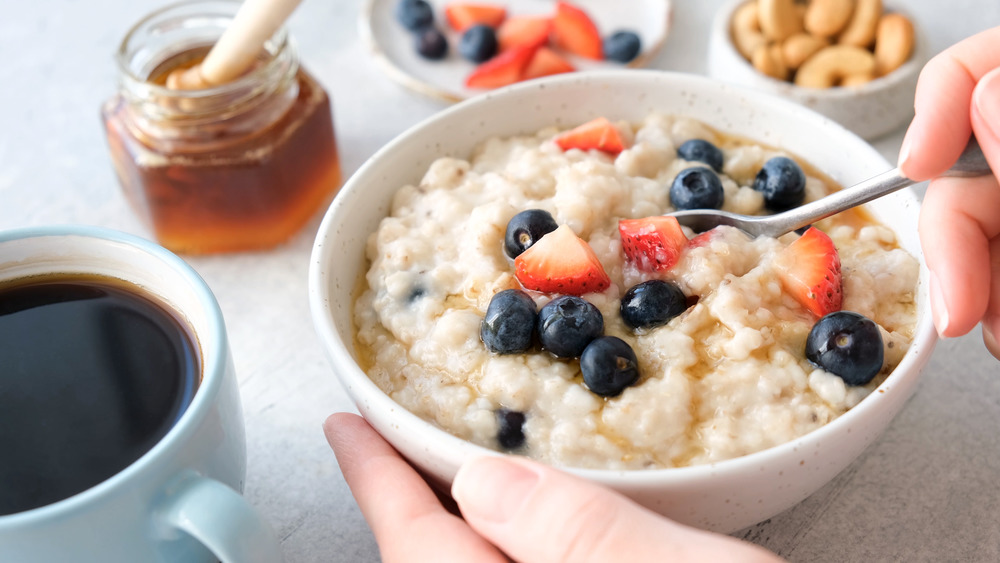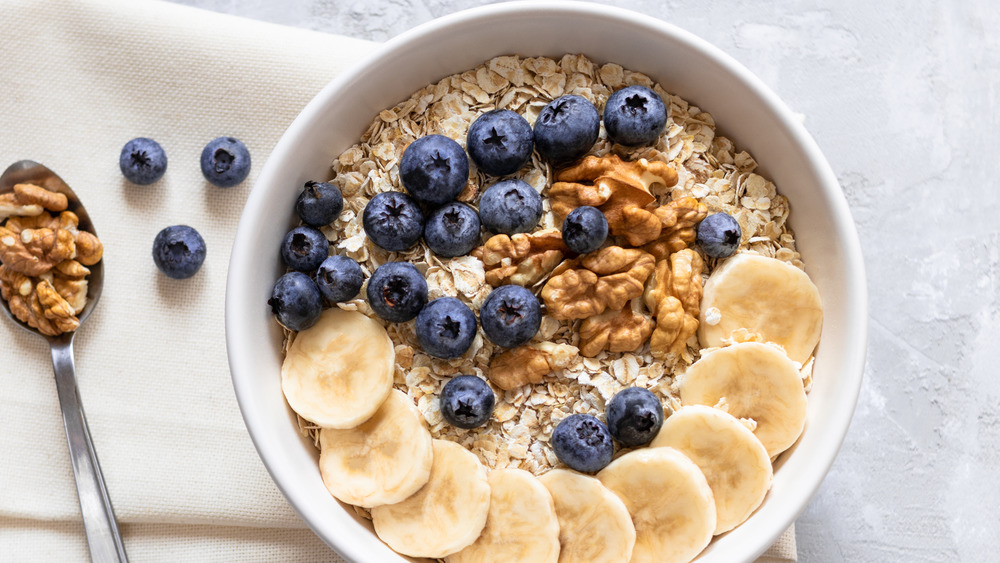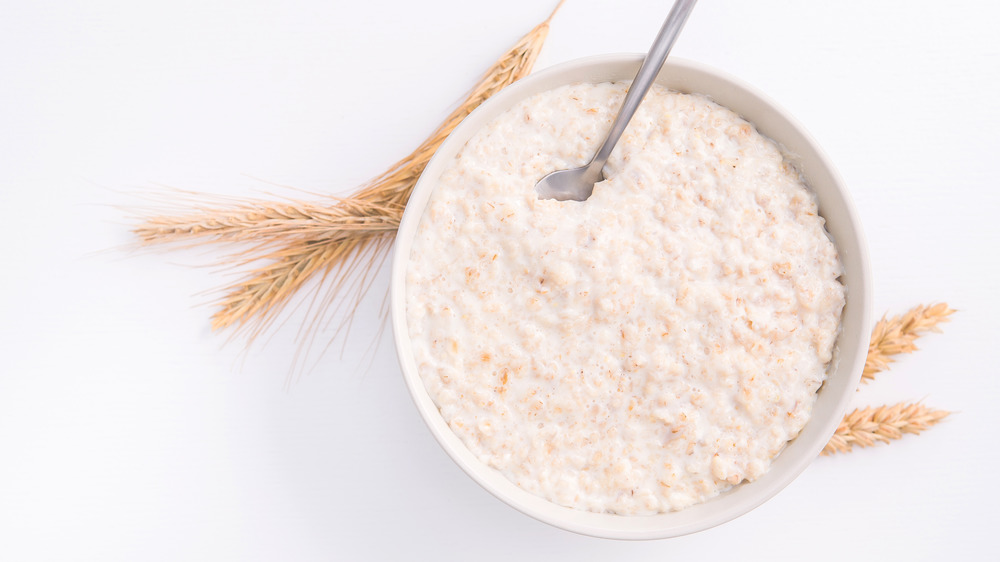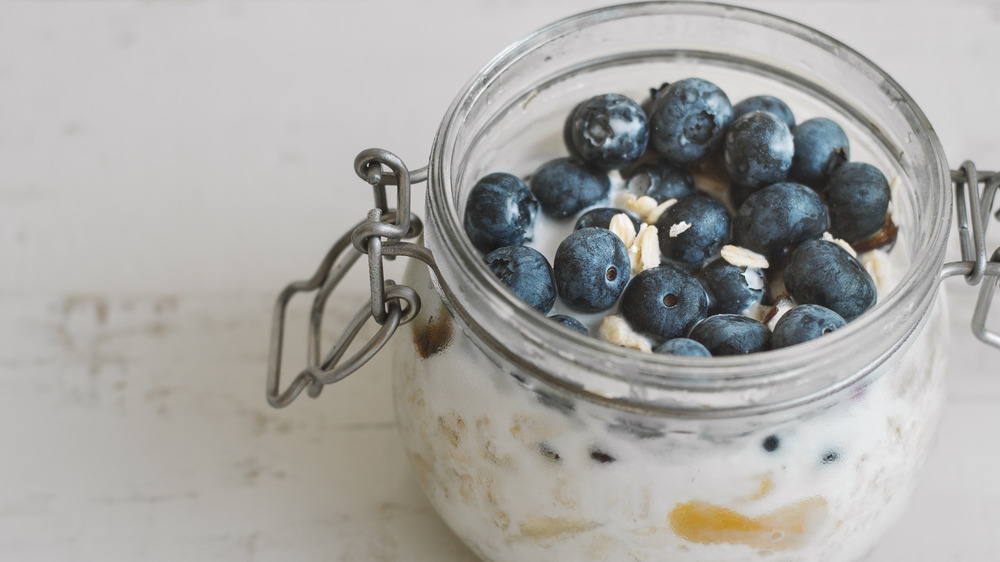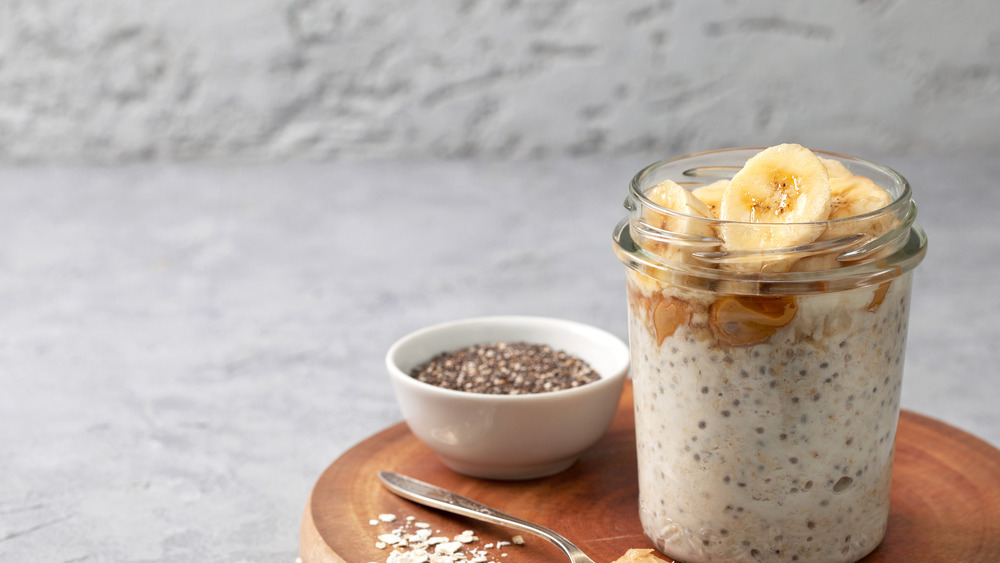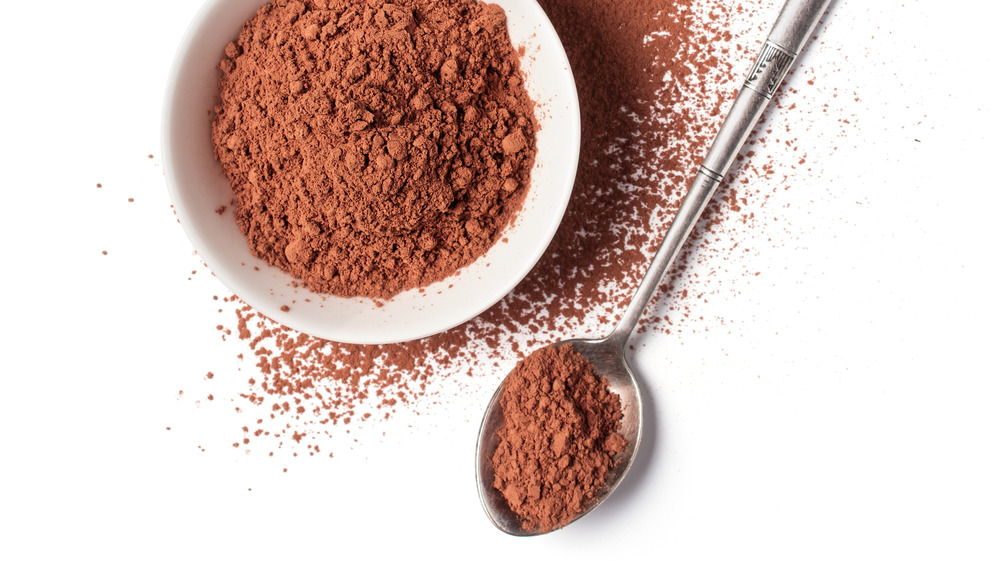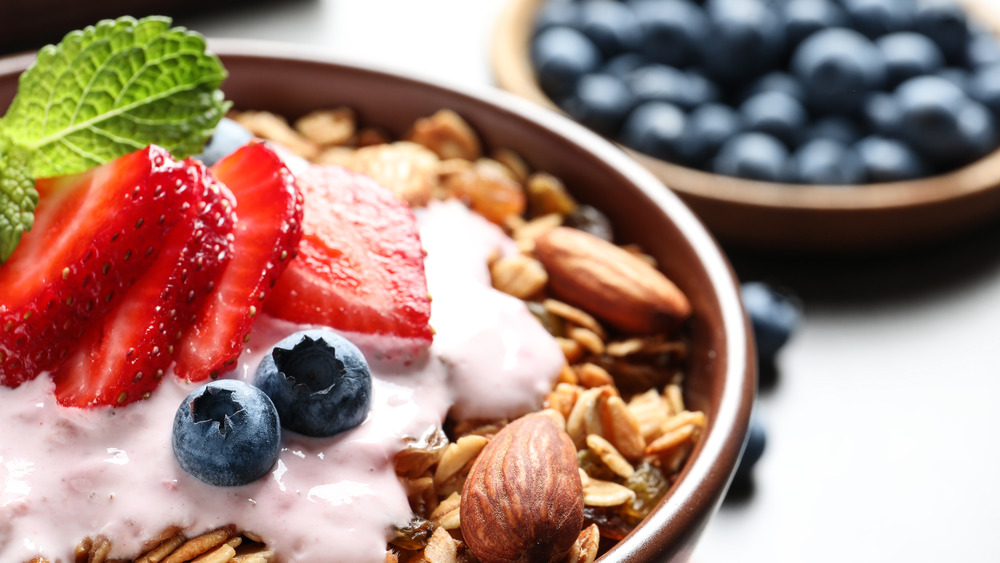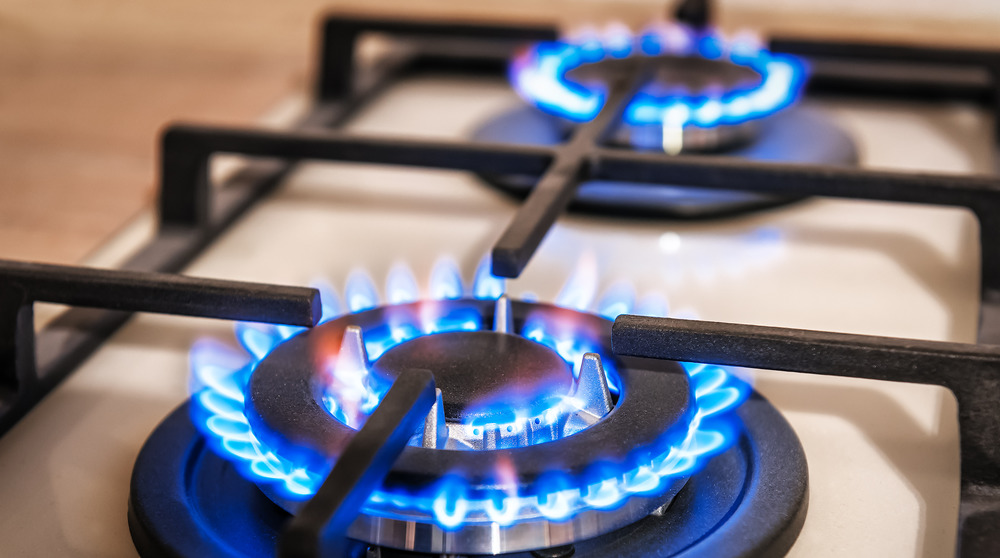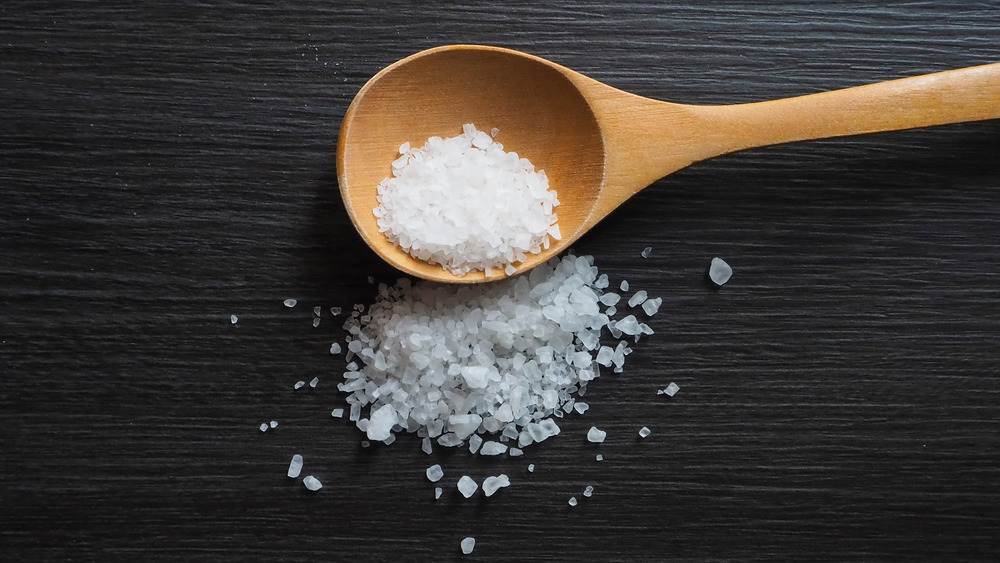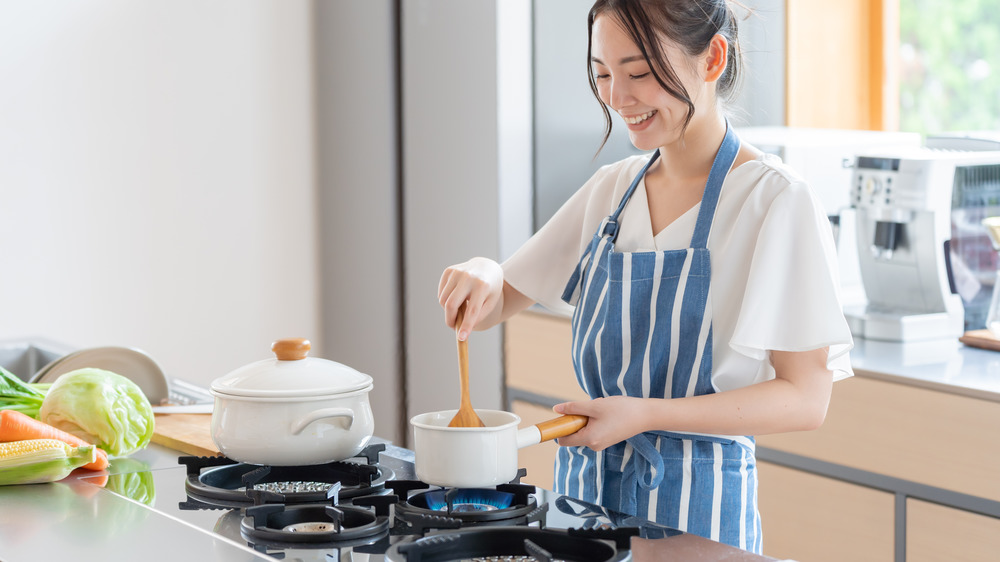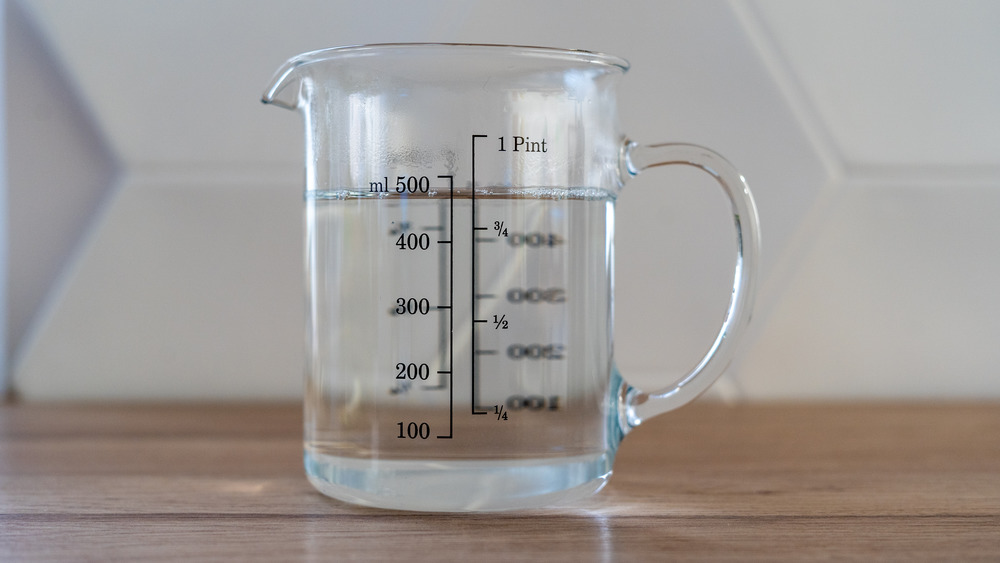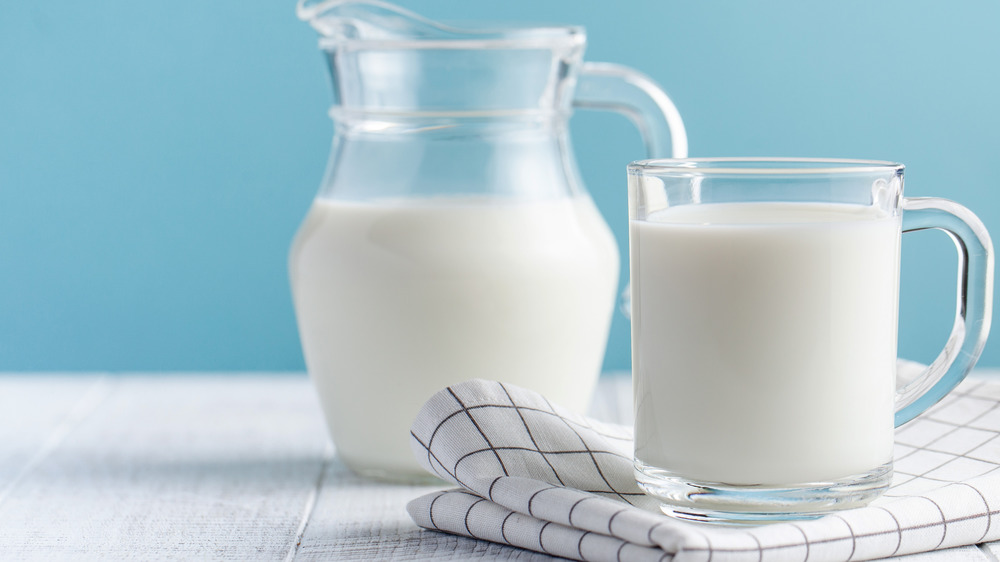Mistakes You're Making With Your Oatmeal
There are a lot of reasons to respect oatmeal, from its fiber content to it being hearty and filling. There aren't many breakfasts as comforting as a warm bowl of oatmeal — especially on a cold morning. Oatmeal is a healthy, nutritious, and delicious part of a well-balanced diet in several important ways, from the aforementioned fiber, to their ability to lower cholesterol levels and improve blood sugar. It's also a delicious way to maintain a healthy weight.
As easy as oatmeal may be to prepare, and as many variations as we can create for it, there's actually a fair amount of ways to mess it up. And as much as we love a good bowl of oats, a bad bowl of oats is a horrible way to start your day. In fact, if you think you don't like oatmeal, we're willing to wager that you've just never had good oatmeal.
So how do you make a great oatmeal? It's more than a matter of deciding between instant oatmeal and steel-cut or rolled oats. There's a lot to consider, and it starts with avoiding these very basic mistakes — and finding the ratio of flavors and ingredients that work best for you and your tastes.
You're eating your oatmeal undercooked
The biggest mistake often seen when preparing oatmeal is eating the oats undercooked. While it's not dangerous — most rolled or steal-cut oats are pre-steamed and heated, according to Healthline, which makes it technically safe to eat raw oats — it can cause other problems for many of us. And we're not just talking about an unpleasant taste or texture.
"Undercooked oats are known to cause gas and bloating for a lot of people," nutritionist Alicia Harper told Mashed. So what's the point in eating a healthy bowl of oats if it makes you feel unwell once you've finished.
Undercooked oats will also be chewy, which is not the texture most people have in mind when they think about a tasty bowl of oatmeal.
To achieve the perfect level of done-ness, cook your oats until all of the liquid has absorbed. If that happens and the oats aren't yet tender, add a little bit more liquid to the pan. Continue this process until the oatmeal reaches the perfect tender consistency you're looking for.
You're overcooking the oatmeal
Of course, the flip side of undercooked oatmeal would be the alternative. That would be overcooked oatmeal, and that's actually a problem as well.
Oatmeal isn't supposed to be a lumpy bowl of porridge where the grains are so soft and mushy that they barely need to be chewed. Instead, it should have an al dente texture, similar to pasta.
To do this, Mackenzie Ryan, a food writer and photographer for Food Above Gold says to, "Cook according to the package instructions, but use only 3/4 of the water amount recommended."
Even with less water, the oatmeal will still release the starch that allows for the smooth, almost saucy base, while maintaining the correct texture of the grain. And there is a fix if you are concerned you have gone too far with your bowl of oatmeal: If you think you've overcooked your dish, try removing it from the heat, and then add a bit of water or milk. Next, stir it. Doing that should add some moisture back in and give it a more appealing consistency. You can also add some nuts or seeds to a bowl of overcooked oatmeal, to help add a little texture back into the dish.
With some practice, you'll find the ratio of creaminess and graininess that works best for you.
You're not soaking your oats overnight
Much like beans, oats will taste better and be better for us with some soaking the night before. Oats contain phytic acid, a substance that makes it harder for your body to absorb minerals like iron, zinc and calcium. That means you simply won't get all the nutrients that may be the reason you're eating the oatmeal in the first place! Thankfully, soaking the oats will help break down those acids, making the oats way easier to digest. Soaking oats is also great because it helps the starches break down, so it's almost like cooking but in a low and slow way (and without heat!).
Ultimately, there'll be a better bowl of oatmeal as a result when you soak your oats overnight, and you'll be glad you put that effort in after. Especially when you're able to have your oatmeal breakfast ready with little-to-no effort in the morning. Just pull it out of the fridge, heat it in the microwave (or eat it cold, if you prefer), and add any toppings you want — unless, of course, you enjoy your oatmeal plain. Breakfast is served!
You're not trying a quick soak of your oats
Overnight oats are fabulous, but they do require thinking ahead. What if you wake up in the morning and decide you're hungry for oats, but you don't have time to cook them? That's a great time to try quick soaking your oats.
"We like overnight oats around here but when I forget to prep it the night before, I will just use quick cooking oats instead of old-fashioned and soak them for 30 minutes in almond milk (or whole milk) the morning of," said Carolyn Truett of the gluten free food blog Caramel and Cashews.
The texture is slightly chewy but delicious. Be sure to add toppings and your favorite sweetener for a really flavorful oatmeal. This is also a perfect option for a grab-and-go breakfast before school or a work commute, and takes away that excuse of passing through the drive-thru for fast food en route to your destination. (Sorry about that!)
You don't give the oatmeal more flavor
Oatmeal on its own can be bland, but adding a few simple ingredients can elevate it to a whole new level.
"Try adding a dash or two of cinnamon, stir in some applesauce for some natural sweetness, or use maple syrup or brown sugar," said Rachel Lessenden, recipe developer and founder of Health My Lifestyle, which is a plant-based recipe website and meal planner.
Other ways to add flavor? Add some texture and crunch with nuts and seeds. Swirl in some peanut butter and add a little vanilla extract. "Giving the base some flavor adds more depth to the dish and makes it more enjoyable," said Lessenden.
It's all about the flavors and textures you enjoy, because those are going to be what creates a better bowl of oatmeal. Wild about ginger? Go for it! If you prefer some cinnamon, that could be your ideal bowl. The best flavors are the ones you enjoy, because you're going to be the one eating it.
You wait until after your oatmeal has finished cooking to add flavor
Chefs will always advise adding layers of flavor as you go with any dish, from the beginning, to the middle, to the grand finale. This is very important to add layers of taste and complexity to whatever you're cooking.
To get the best flavors in your oatmeal breakfast, the same holds true. Add your spices and add-ins while it is cooking, advises food expert Gwen Leron. This will give your breakfast the deepest flavor and soften up any add-ins you choose to include.
To make things easier, keep frozen fruit on-hand and add some in while your oats are cooking. They'll soften while the oatmeal cooks, and infuse the entire oatmeal dish with the flavor of their juices. It'll result in a seriously delicious (and beautiful) bowl of oatmeal that doesn't even need sugar for sweetness. How's that for a perfect breakfast?
You use too much heat when you cook your oatmeal
One of the biggest mistakes you can make when making your oatmeal is using a heat that is way too high.
Cooking at too high of heat will cause the oatmeal to burn and stick to the bottom of the pot. That's not good for your oatmeal, or the pot that it's being cooked in.
"The key to a successful bowl of oatmeal is to cook it over medium-low heat for the amount of time specified in the recipe you are following," said Gwen Leron, a home cook and food expert, who runs the food blog, Delightful Adventures.
You want the oatmeal to bubble a bit, so heat is important, but going too far will be bad, so keep an eye on that flame! If you don't, you'll spend a good portion of your morning trying to remove that burnt oatmeal from the bottom of your pan.
You didn't add salt to your oatmeal
Salt is perhaps the most important seasoning of them all. It's not good to overdo it, but underdoing it can unravel a dish quickly.
Don't forget to add just a quick pinch of salt to the water before you add the oatmeal to the pot. "It may seem counter-intuitive if you're preparing a sweet bowl of oats, but doing this will enhance the flavor of your breakfast," said food expert Gwen Leron.
Adding that all-so-important pinch of salt at the beginning of the cooking process will be a good way to achieve that perfect nutty and toasty porridge-like oatmeal that we all crave. We don't taste the salt, but we'll sure miss it if it's not there.
Adding the salt at the end won't achieve that same flavor (in fact, it may just make your sweet oatmeal taste oddly salty...) so be sure to make it an early step.
You're not stirring your oatmeal while it's cooking
Stirring is an essential part of many cooking processes, and that includes those oats.
You need to stir the oatmeal while it's cooking in the pot so it doesn't burn, says Raymond Cua, founder of Travelling Foodie. But that's not the only reason. The act of stirring ensures a consistent texture and taste, and will help prevent all those lumps and uneven cooking (or aforementioned sticking to the bottom of the pot). The perfect oatmeal is creamy in texture, and consistent stirring does a lot along the way to help this to happen.
But don't over-stir your oatmeal, either. You want the oats to still have a bit of a bite to them, and still maintain a rustic texture with just the right creaminess. Stirring your oats too much causes them to produce too much starch, which Kitchn says leads to gummy oatmeal.
You're not using enough liquid in your oatmeal
It's very important to use the right ratio of liquid to oats when making oatmeal. Not enough liquid will, of course, make them dry and clumpy. Too much liquid, on the other hand, may turn them into mush (or worse, soup).
If you're using quick oats or rolled oats, Eating Well says you'll need one cup of liquid for every 1/2 cup of oats. If you're using steel-cut oats, you'll need even more liquid — one cup for every 1/4 cup of oats.
"Make sure to start with water or soak them overnight," said Palak Patel, chef at the Institute of Culinary Education. Add any liquid after the cooking is completed for a creamy texture. If your oatmeal appears runny, you can always cook it a bit longer to soak up that extra liquid (much as we might with rice or lentils or even grits) but a dry, sad oatmeal is a sad alternative!
You're using the wrong liquid
Whether you use milk or water, it's important to pay attention to order and consistency. No one wants mushy and watery oatmeal for breakfast.
Chef Chris Valdes, a former Food Network Star finalist, says if you're cooking your oats, milk shouldn't be the liquid you grab first. "One of the most common mistakes that I see people make when making oatmeal is that they use milk as their primary ingredient, and then they wonder why they end up with a mushy oatmeal rather than a creamy oatmeal," he said.
Experts over at Kitchn agree, saying using milk when cooking oatmeal creates sticky and gluey oatmeal.
To achieve creamy oatmeal, Valdes recommends you start by using water as your main liquid first, sprinkle in some salt (again, this step is very important), and once the water comes to a boil, add in your oats and bring down the heat and allow it to slowly cook. Right before serving, add a splash of your desired milk — be it plant-based or dairy milk — and then top your oatmeal with your favorite ingredients and serve.
